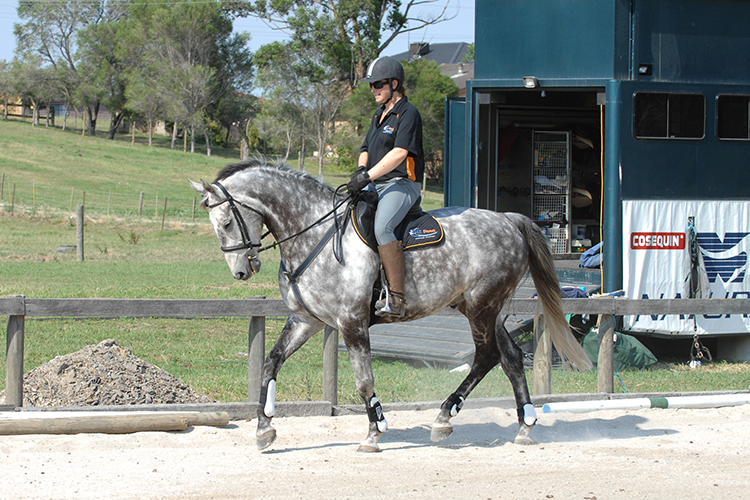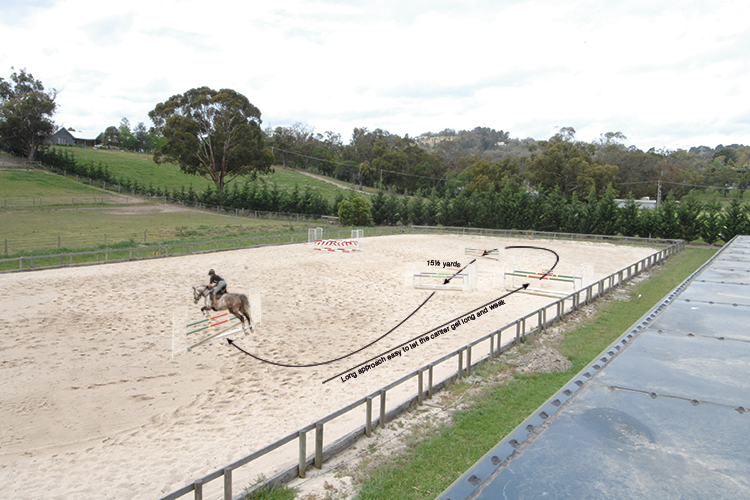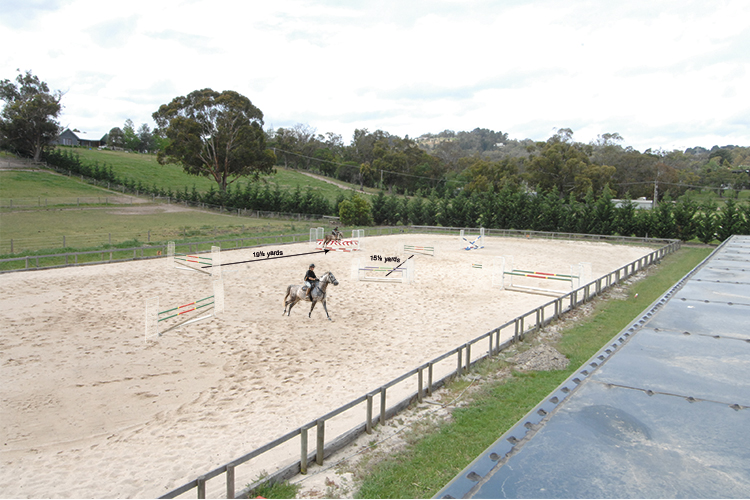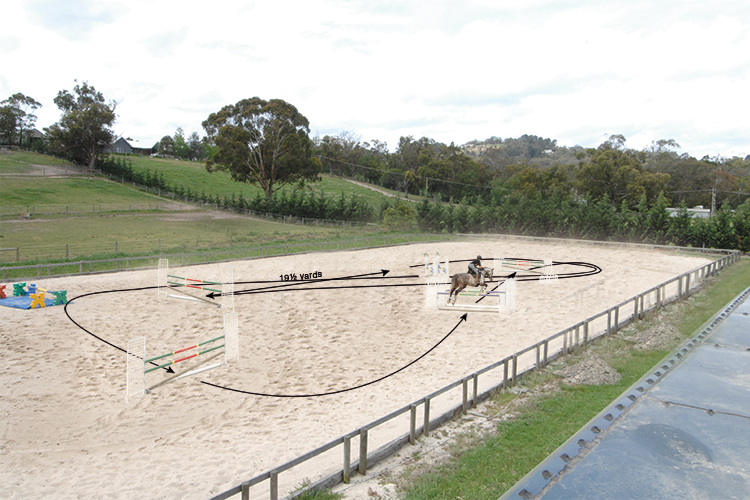 Once again we are joining exciting young showjumping rider, Amy Graham as she works with her imported Dutch gelding, Transatlantic. Last month, her trainer, Michelle Strapp had Amy concentrating on her flat work, getting the movement longer and looser and trying to correct the horse’s crookedness, the exercises in this working session are designed to reinforce the work on the flat.
Once again we are joining exciting young showjumping rider, Amy Graham as she works with her imported Dutch gelding, Transatlantic. Last month, her trainer, Michelle Strapp had Amy concentrating on her flat work, getting the movement longer and looser and trying to correct the horse’s crookedness, the exercises in this working session are designed to reinforce the work on the flat.
Michelle is stressing the quality of the canter:
“So today we warm up over a basic cross rail, over a vertical, start a few lines and keep working on the canter all the while. You need a good enough canter to take you down the fifteen and a half yards from the vertical out of the corner on the left rein – where he normally drifts right with his shoulder – to the oxer. You are not going to jump the vertical on a short canter and then have to chase him down to the oxer. As soon as you land, I want you to ride leg to hand, a bigger canter, so that even if you take a second option it is within a bigger canter, not a second option within a short canter because then you have to chase him down the line…”

The horse is nicely warmed up, time to tackle the line:
“Amy comes on the first fence after she comes round the turn. She just has to ride this as smooth as possible, with a low steady hand. She’s taking a second option, very good. Now leg to hand so the canter is big, so she catches the second fence a little forward – FORWARD, bigger canter – she did it beautifully, now she is going to ride the three to the oxer. EASY. Now normally that horse would struggle down a line like that, and she was waiting for the three. If she had caught the vertical on a short, shuffly canter, she would have had to chase him to the oxer. LOWER. Low hand, wait, wait with the body, soft hand. Very good – she rode to plan.”
Wait with the body…
Riders can get into the habit of leaning forward to the fence, once they they have seen their distance (takeoff) and try to ride forward from their shoulders – thus they get ahead of the motion and the horse will become out of balance.
The advantage of riding with a waiting body, a tall body, is that the rider remains closer to the saddle, thus keeping the horse more collected and balanced, with more weight distribution on their hind end. It also works as a holding force, so you can keep your hands softer. It helps teach a rider to be patient and sit still land wait for the ideal spot to appear. It’s lack of confidence that makes riders too eager to see the distance, causing them to rush the process.
“He used to come round the corner in a short canter with his neck twisted, so when he jumped the vertical what he would do is land over his right shoulder, drifting right, he always had his bum to the left and his shoulder to the right. And if you rode him forward, he found it hard to straighten his body, and that’s why we rode him a lot in shoulder fore to the left, to try and straighten him so he stretches all that side. Now she can get the better canter into her hand, and she can soften her hand and he still stays in the chute.”
Chute
On your track to the fence and away from the fence, when the horse directs its energy between your two legs and into your hands, you are taking control of all four legs, so the hind legs follow the front legs.
When your horse is not straight and in your chute, the power developed by the hindquarters does not go straight but pushes the forhand to one side. Straightness, I believe, is a more crucial principle than collection when training.
“Before when she softened her hand he’d fall over, now she has the feeling that as she softens, he has more scope because he goes longitudinally through the body. When the horse used to land with the canter a bit short and crooked, then Amy had to kick and go crazy to go down the lines – or they she’d end up over-adding. She ended up over-adding because her eye told her it was too long – so she added down lines she didn’t need to. That’s what we’ve really been working on. Now because he travels through his body and has a lot more self-carriage, he actually adds another half a metre to his scope, to his jump, because he can cover the ground down the line.”
Over Adding…
If the related line is built to ride a regular 3, 4, 5, or 6 strides, it is ideal that your horse can travel down the line in those strides. To do this the important fact is that the rider knows the pace to ahieve that many strides. It is important to know if your canter is open enough or collected enough to suit the line. Because Transatlantic would get short on the approach, it would encourage Amy to put in six strides instead of five. There are times when we may want to add down a line, but it is also imperative to know we can trael down the true distance when needed. Hence we need to fine tune the canter to do that…
Amy is beaming, she is happy with the result: “He was beautiful the way he got the vertical.”
And her hard task master of a coach, agrees:
“Yes he was lovely because you rode it legs to hand, and this is the vertical where he normally tips over his shoulder, but he stayed really straight.”
Michelle resets the course…

“This time is it a little tougher because she has to jump round the tight turn to the vertical, to the oxer, and that distance of 191/2 yards will ride a little long because it is out of a tight turn away from the entrance. In the past, if she could get the speed up, but there is not enough room for speed, it is going to be the strength and length of her canter that will give her the correct pace for the distance, she could get down the line, but this time I want her to catch that vertical a little open to the distance so he is not too jammed at the base and he lands too short. I want him a little more open so he is freer over the vertical, so the four will come, she just needs to canter down the distance not having to chase. Through the turn, he not only has to stay in that chute, but he has to keep that ground covering canter without running.”
“Then, once she’s done that, right rein, the Stile, then left rein back over the oxer then the vertical.”
Start from number one, the white fence. White, rustic, vertical, oxer, right rein, stile…
See a distance…
A eye for a distance comes with experience. It’s a bit like ‘feel’, it takes time. It requires teaching riders to understand what strides or take off is produced from different canters. If the canter is well-balanced and the horse is travelling to the fence in our chute, a distance will appear and in time, the rider will instinctively pick this up. As a trainer, I find it very important to work on the rider’s pace to a fence first, and then let their eye complement the canter as the become more experienced.
Eye for a distance is imperative at a higher level, however the eye should still complement the pace.
When the rider has developed a sense of timing (eye) and they have a good canter, they will often see a moving up distance or a waiting distance. This is what we call the first or second option. If the horse is not in front of your leg, it is very hard to travel to get a second option as your motor drops away as you sit still and wait and in that situation you instinctively pick a chasing distance. Your strength of pace (activity) is a rider’s best friend in the ring, it gives you the confidence that you do not need to rush the process of picking up the distance too far out from the fence.
Michelle wants Amy to keep the softness she developed in the session on the flat:
“You have a good rhythm, you’ve just got to think of the balance of the canter and the straightness of the canter and you will see your distance, your eye will match your canter. You want to feel that your hand melts… once you know you have your distance, feel that your hand melts, so that you encourage your horse to stay soft off the ground. Encourage him to use his shoulder, to use his neck, which encourages more scope.”
Hand Melts
The hand, arm and elbow need to relax and try not to become tension. A relaxed hand will produce a much softer jump. Once you have your distance, you arm just follows or directs the jump and does not help the horse jump the jump by pulling the reins or lifting the horse off the ground.
And he has to travel…
“Get him straight up into 400 metres per minute, shorten your reins so your elbows are just in front of your body. Big canter, legs to hand, through to the bridle, lovely, travel, travel, travel – good girl. Back together now, upper body comes back, you’ve got a stile now, sit up a little, sit up and balance. Body back, don’t let the canter get floppy, leg to hand, beautiful, you even got deep on the three, yeah. You can afford now, because he is starting to cover the ground, that your body comes back in distances like that for your vertical. Remember how you got caught at Elysian Fields and had 4 faults, because your body didn’t come back.”
Your canter to the oxer, the last line – what did you think?
“It was a little bit open…”
“A little bit open, a little bit weak. It’s not the option I am talking about, it’s the quality in the canter. Once you jumped the stile you needed a better connection in that bigger canter – the bridle was getting further away from the hind leg, so then the distance that looks obvious is the sloppy distance. Even though you feel he is getting soft in the neck, you have to keep the hind legs coming to the bridle.”
“We’ll add that nice vertical now.”

“First of all she is doing a steady five from vertical to stile, so it is a short five, and then we are going to come off the left turn and jump the vertical down to the oxer, so if she catches the vertical a little open and straight, it means she is allowed to be waiting when she gets to that oxer. After the oxer she has a tight turn to a tall vertical. What often happens in that situation is once they’ve jumped the oxer they might be running, then you tend to be too much on their head to get to the vertical – so they are concentrating more on the rider than the fence.”
“What I am asking her here, is to make sure she does catch the vertical a little open, then she can be steady for that oxer, she can open up her upper body a little earlier over the oxer but still leave her hand forward so the horse still jumps the back rail and uses himself, but if her body starts to open up a little earlier, she’ll control the first landing stride with more balance. So it helps control that turn, so when she gets to the vertical, she’ll have a steady hand. When you ride horses like this that are naturally careful, they will do their best to jump it as long as you allow them to look at it – but if you are on his case, he is more concerned or distracted by the rider than the jump.”
“Then you come round, after that you’ve got the stile again, off the right rein, then left and your oxer to your vertical – won’t ride as long as it did away from home, so you should be able to jump the oxer with a good canter and then be able to wait with your upper body to the vertical. If you do all that beautifully, then you can knock off.”
Once again at the end of a very nice little round, with just a sloppy first fence down, it’s time for the analysis:
“He wasn’t too deep, he’s a horse that is good in front. How did the balance of your canter feel? You were leaning over his neck too much, you were running the canter, running him on to his shoulder. He’d been standing and walking for a while, it was a bit of a dumb mistake on his part – if he’d actually jumped a few fences he would have helped you there, but he would have helped you by doing a little twist or something. He’d half gone to sleep but your canter was too running and too on the forehand. Remember that’s the fine line, to keep him coming through from the back but not sloppy.”
So it’s try try try again…
“Here’s a vertical, stay taller with your body off the turn. You were leaning at the vertical with your body…”
And the next time it is fine.
“Beautifully ridden, good girl, body SIT UP TALL, reins too long, SHORTEN YOUR REINS! Your reins are too long!! Much better, much better, body back, leg to hand, beautiful.”
But the rider is not happy: “It was terrible.”
“No it wasn’t terrible, there was lots of good stuff there. Don’t be too tough on yourself. Lots of beautiful body control, super and straight. You reins got long over that oxer, so then you ended up with your hands up high, trying to wait, you brought your body back but your reins were too long. And you added down the first line too. That’s what you are cross about.”
One last time…
“Shorten your reins, your fingers closed, beautiful, one, two, three, four, five, super. Great now keep your fingers closed. FINGERS CLOSED! SIT TALL!! Very good, sit tall, body back body back body back, it’s a stile. Body back, lovely, body back, sit up – good girl.”
At last the coach is happy:
“Yesterday when we were playing around and we were talking about your body coming back, and I built this course for you – and I’ve been mean because I’ve built her a course that makes her do a lot with her body control and balance of the horse. This is where it comes into play – from the oxer to the vertical. You don’t have a lot of time when you jump the big tracks indoors, if you are too slow to get your body back, or think about your balance you’re gone – all that has to be automatic. You can’t be thinking about that when you are jumping a World Cup track at 1.60.”
“That’s why it is so important that every stride of the canter you are looking for that balance, if he gets too long and flat, you bring your angle back. Don’t say to yourself, ‘I’m going to do light seat work now on the flat’ so you stay light seat, even if your canter feels out of balance. No – the canter is out of balance, get your body back, rebalance the canter, then become lighter again.”
This is a pupil who really tries:
“Amy is very hard on herself, you have to be very careful with her. She’s hard on herself in competitions, and she tries too hard. It’s a blend, she’s come to a trainer who is a perfectionist anyway… and one thing I learnt as a competitor, is that you have to keep that mental balance. If she goes into a class now, she just goes in to have fun and if we want to win the class, she does whatever is needed to have a go, that’s why she trains. You’ve done all the homework, so go and have fun – and I think she is starting to do that now in competition. She goes in with a smile on her face and all her good work gets put into practice, and she rides enough good fences that if she makes the odd little mistake, she’s got enough money in the bank – that’s a saying I pinched off George Sanna – she’s got enough from all the good rides, that if she makes the odd little blue, the horse can actually help her out there.”

And guess what? We finish with just a tiny bit more of that stretching on the flat routine:
“This horse needs to learn to warmup with his nose on the sand – walk, trot and canter, he needs it because of the way he is built. He is not exceptionally long in the rein so he needs to use every bit of his body – he’s a really honest jumper, a really careful jumper. The challenge is getting him moving as an athletic machine. The crazy thing about this sport – I don’t know why – but in every other industry, be it golf or tennis or whatever, if they have a weak link in one arm, what do they do? Twenty more lifts to strengthen it. But riders rarely look at that with a horse – they never say, this horse needs to be an athlete, it needs to deal with every part of its body.”
“Most people know how to get to the point of takeoff. How do you improve the jump itself? Get deeper, get longer – if you can’t improve the physical capability of the horse to get from one fence to the other, then there’s not so much you can do. That’s when riders might go to the tricks – V poles, grids, they are all tricks, that don’t actually help the longevity of the horse’s career, but they can be used in conjunction with good flat training,”
“Those tricks don’t give you that extra bit you need at an Olympics where the horse has to actually bust itself – to give that extra effort, the horse has to be in shape to do it. But if they move around like short rigid crabs, and when you give them rein, they never take it – give rein and they run. It’s just logical that you work the horse as an athlete instead of just using up the horse’s natural talent. If you keep drawing on their raw talent, in the end their hearts won’t keep it up, they don’t want to do it – or their bodies break down.”
“I keep coming across young kids jumping, they know how to get over a fence, but they are not riders, no one has taught them how to ride. I had one young rider, he jumps around 90 cm, he gets loose, he doesn’t know how to manage his canter, and he goes off and does a clinic and comes back: ‘Oh, I’m really excited they got me jumping metre fifteen fences.’ So the coach – whoever it is – should be able to see that this rider has a lot more issues, he can’t even sit on the horse’s jump – so what is going to happen in combinations and lines? Why would a coach stand there watching a child with no position over a fence, can’t maintain a canter, doesn’t know what lead he is on – and have him jumping metre fifteen tracks??”
For Amy and Transatlantic it’s getting the balance right:
“With combinations like this we want to improve the way the horse moves while still working on her jumping. It has to be an aim, and a gradual process, the horse needs to be jumping fit, so we have to jump it a bit – but the more elastic, the more athletic the horse gets, that has to be the focus because that is what is going to let the horse jump World Cups for her…”
“That’s what Gilbert Böckmann said to me, ‘Michelle this has been around for hundreds of years, it is not a new way of training”.
You been impressed with Gilbert’s training?
“I think he is right for us. Franke Sloothaak is a lot stronger but I think a few of riders came out of his clinic not that happy, maybe misunderstanding what he was trying to achieve. I think that at the moment Australians just need that softer approach until they understand… With Gilbert there are no gimmicks, just good simple, basic training: horses have to be balanced, they have to be soft, riders have to learn to ride from leg to hand – not from hand to leg.”
How is he relating to the Australian trainers?
“Ask Amy, he said to her at the end, I’ll leave you alone, I’ll leave you with Michelle, as I said, he is very nice! He’s wonderful, he wants you in on it, he wants to train the trainers. I said to Gilly, please come to the practice fence and watch me warm up Amy, give me some feedback so we are talking on the same lines. He asked me questions – why are you doing that? And we could discuss it – he’s very supportive. What he really wants is a team of coaches on the ground that can teach people to ride, so that when he gets here he can fine tune and complement that.”
It must be a bit of a shock, dealing with some of the flat work?
“He’s trying to teach riders the feel of a half halt, what straightness is, shoulder in – how to do a leg yield – he shouldn’t have to do that. He should just be fine tuning the riders.”
“Like he sat down and watched the video of Amy and he said ‘you are thinking too late down the line, when you had the four faults. You need to get your body back earlier…’ If she was on a horse that is rigid, and fierce and its head is on one side, and he says ‘bring your body back’ it’s not going to have an effect when all the rest is going wrong. It’s a building block onto the structure of teaching…”
“He was a very honest coach. To some people he explained that a horse will not reach its full potential until they get flat training. He said ‘you have to learn to train your horses on the flat. You’ve got a super jumper, but unless you get a flat trainer, educate yourself to train him’.”
In part three – Michelle and Amy work with Prada – Amy’s D grader…
This article first appeared in the March 2008 issue of THM.


